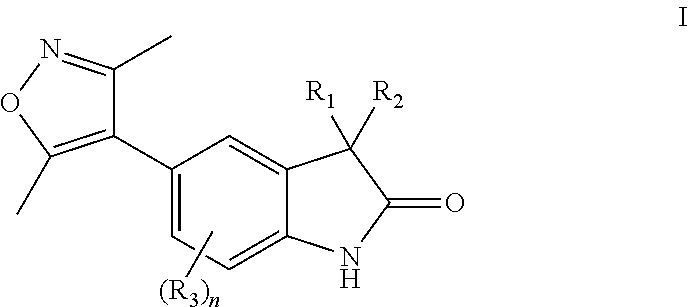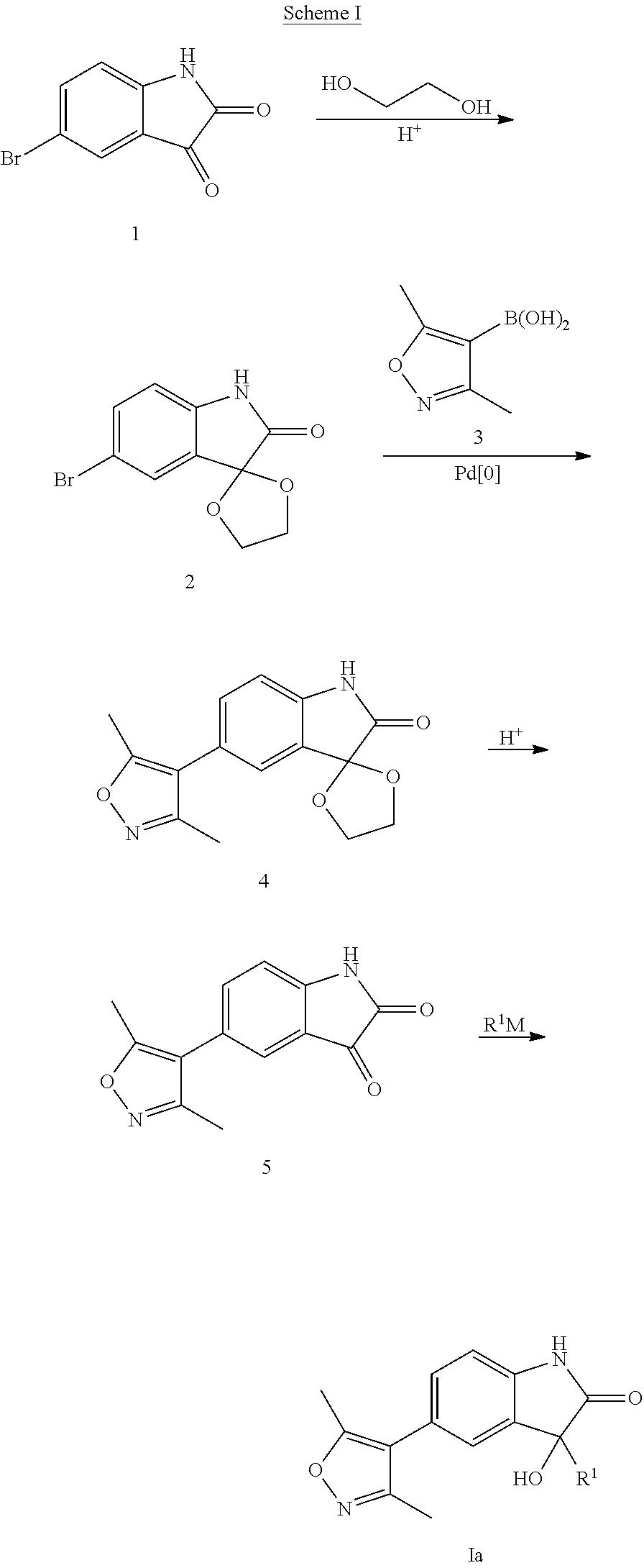Substituted 5-(3,5-dimethylisoxazol-4-yl)indoline-2-ones
a technology of dimethylisoxazol and indoline, which is applied in the field of substitution of 5(3, 5dimethylisoxazol4yl) indoline2ones, can solve the problem of major challenge of persistence of latent hiv-1
- Summary
- Abstract
- Description
- Claims
- Application Information
AI Technical Summary
Benefits of technology
Problems solved by technology
Method used
Image
Examples
example 1
Synthesis of Compound 1.1-1.34
[0177]Compound 1.1
[0178]
Step 1: 5′-Bromospiro[[1,3]dioxolane-2,3′-indolin]-2′-one
[0179]
[0180]A magnetically stirred solution of 5-bromoindoline-2,3-dione (226 g, 1.0 mol, 1 eq.), ethylene glycol (186 g, 3.0 mol, 3 eq.), p-TSA (30 g, 0.16 mol, 16 mol %) and toluene (1500 mL) was refluxed overnight using a Dean-Stark apparatus. After total consumption of 5-bromoindoline-2,3-dione, EtOAc (1500 mL) and water (1000 mL) were added to remove excess of diol. The aqueous layer was extracted twice with EtOAc (500 mL). The collected organic layers were collected, dried over Na2SO4, filtered and concentrated under reduced pressure. The yellowish solid was washed with diethyl ether to give the desired compound as a pale yellow solid (236 g, 87%). 1H NMR (400 MHz, DMSO-d6): δH 10.56 (s, 1H), 7.31-7.33 (m, 2H), 6.93 (d, J=8.0 Hz, 1H), 4.27-4.35 (m, 4H), 2.35 (s, 3H), 2.18 (s, 3H). MS (ESI) m / e [M+1]+ 270, 272.
Step 2: 5′-(3,5-Dimethylisoxazol-4-yl)spiro[[1,3]dioxolane-...
example 2
Synthesis of Compound 2.1-2.58
[0207]Compound 2.1
[0208]
5-(3,5-di methylisoxazol-4-yl)-3-(2-hydroxyethylamino)-3-phenylindolin-2-one
[0209]34 mg (0.1 mmol) of 3-chloro-5-(3,5-dimethylisoxazol-4-yl)-3-phenylindolin-2-one and 86 mg (10 mmol) of 2-aminoethanol were solved in THF (5 mL), the reaction solution was stirred for 16 h at room temperature. Subsequently, the solution was diluted with water. The aqueous phase was extracted with CH2Cl2 (2×10 mL). The combined organic phases were washed with aqueous NaHCO3 and with water, dried and concentrated in vacuo. The resulting residue was purified by silicon gel chromatography (eluent: EtOAc / MeOH=50 / 1) to give product (20 mg, 55%) as a white solid. 1H NMR (400 MHz, DMSO-d6): δ 10.67 (s, 1H), 7.44 (d, J=8.0 Hz, 1H), 7.18-7.34 (m, 5H), 7.18 (s, 1H), 6.99 (d, J=8.0 Hz, 1H), 4.51 (t, J=5.6 Hz, 1H), 3.40-3.42 (m, 2H), 2.96-2.99 (m, 1H), 2.40-2.42 (m, 1H), 2.35 (s, 3H), 2.27-2.29 (m, 1H), 2.17 (s, 3H). MS (ESI) m / e [M+1]+ 364.
[0210]Compound 2.2
[02...
example 3
Synthesis of Compound 3.1 through 3.10
[0271]Compound 3.1
[0272]
5-(3,5-Dimethylisoxazol-4-yl)-3-phenylindolin-2-one
[0273]To a solution of 5-(3,5-dimethylisoxazol-4-yl)-3-(2-hydroxyethylamino)-3-phenylindolin-2-one (32 g, 0.1 mmol) in dichloromethane (500 mL) was added trifluoroacetic acid (20 g) and triethylsilane (20 g). The brown solution was stirred at ambient temperature for 3 h and concentrated in vacuo to dryness. The residue was diluted with dichloromethane (500 mL), washed with saturated ammonium chloride solution (200 mL), brine (3×400 mL), dried over anhydrous sodium sulfate and filtered. The filtrate was concentrated in vacuo to dryness. The residue was crystallized from ether to give the title compound. 1H NMR (400 MHz, DMSO-d6): δH 10.63 (s, 1H), 7.18-7.36 (m, 6H), 6.99-7.04 (m, 2H), 4.82 (s, 1H), 2.32 (s, 3H), 2.15 (s, 3H). MS (ESI) m / e [M+1]+ 305.
[0274]Compound 3.2
[0275]
5-(3,5-dimethylisoxazol-4-yl)-3-(3-hydroxypropyl)-3-phenylindolin-2-one
[0276]A mixture of 5-(3,5-dime...
PUM
 Login to View More
Login to View More Abstract
Description
Claims
Application Information
 Login to View More
Login to View More - R&D
- Intellectual Property
- Life Sciences
- Materials
- Tech Scout
- Unparalleled Data Quality
- Higher Quality Content
- 60% Fewer Hallucinations
Browse by: Latest US Patents, China's latest patents, Technical Efficacy Thesaurus, Application Domain, Technology Topic, Popular Technical Reports.
© 2025 PatSnap. All rights reserved.Legal|Privacy policy|Modern Slavery Act Transparency Statement|Sitemap|About US| Contact US: help@patsnap.com



